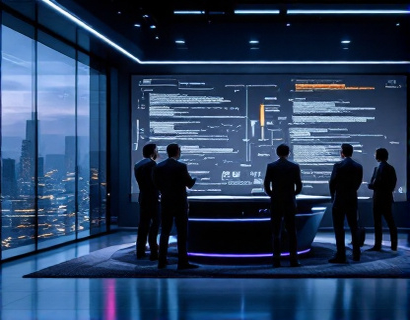Streamlining External Collaboration and Management: Advanced Software Solutions for Business Efficiency
In today's fast-paced business environment, effective collaboration and management of external stakeholders such as users, partners, and contractors are crucial for success. Organizations of all sizes face challenges in coordinating these external relationships, often leading to inefficiencies, miscommunications, and increased operational costs. Advanced software solutions are emerging to address these challenges, offering innovative tools to streamline the management of external collaborations and enhance overall productivity.
Challenges in External Collaboration
Managing external stakeholders involves numerous complexities. One of the primary challenges is maintaining clear and consistent communication. Without a centralized platform, emails, messages, and documents can become scattered, making it difficult to track progress and ensure everyone is on the same page. Additionally, managing user access and permissions can be cumbersome, especially when dealing with a large number of external parties. This often results in security risks and compliance issues. Another significant challenge is the integration of various tools and systems, which can lead to fragmented workflows and reduced efficiency.
Importance of Streamlined Collaboration
Streamlining external collaboration is not just a convenience; it is a strategic imperative. Efficient collaboration can lead to faster decision-making, reduced project timelines, and improved customer satisfaction. For businesses, this translates into a competitive edge, higher profitability, and better resource utilization. By optimizing the management of external stakeholders, organizations can focus more on core business activities and less on administrative tasks.
Key Features of Advanced Software Solutions
Advanced software solutions designed for external collaboration and management offer a range of features that address the aforementioned challenges. These solutions typically include:
- Centralized Dashboard: A single platform where all external stakeholders can be managed, monitored, and communicated with.
- Role-Based Access Control: Fine-grained permissions to ensure that each stakeholder has access only to the information and tools relevant to their role.
- Automated Workflows: Predefined processes that automate routine tasks, reducing manual effort and minimizing errors.
- Real-Time Reporting: Comprehensive analytics and reporting tools to track performance, identify bottlenecks, and make data-driven decisions.
- Integration Capabilities: Seamless integration with existing systems and tools to create a cohesive workflow.
- Secure Communication: Encrypted channels for secure messaging and file sharing, ensuring data privacy and compliance.
Centralized Dashboard
A centralized dashboard is the cornerstone of any advanced collaboration software. It provides a unified view of all external stakeholders, allowing managers to monitor activities, track progress, and manage tasks in one place. This reduces the time spent switching between multiple platforms and ensures that all relevant information is easily accessible. For instance, a project manager can view the status of contracts, monitor the progress of deliverables, and communicate with contractors all from a single interface.
Role-Based Access Control
Managing access rights is critical for maintaining security and compliance. Role-based access control (RBAC) allows organizations to define specific permissions for different user roles. For example, a contractor might have access to project documents and timelines but not to financial data. This granular control ensures that sensitive information is protected while still providing necessary access to external stakeholders. RBAC also simplifies the onboarding process, as new users can be quickly assigned appropriate levels of access based on their role.
Automated Workflows
Automation is key to reducing manual overhead and improving efficiency. Advanced software solutions can automate routine tasks such as sending reminders, updating statuses, and generating reports. For instance, when a milestone is reached, the system can automatically notify relevant stakeholders and update the project timeline. This not only saves time but also reduces the risk of human error, ensuring that processes are consistently followed.
Real-Time Reporting
Real-time reporting capabilities provide insights into the performance and progress of external collaborations. These tools can generate detailed reports on various metrics, such as project completion rates, stakeholder engagement, and cost expenditures. Managers can use these insights to identify areas for improvement, optimize resource allocation, and make informed decisions. For example, if a particular contractor consistently misses deadlines, the software can flag this issue, allowing the management team to take corrective action.
Integration Capabilities
Integration with existing systems is essential for a seamless workflow. Advanced collaboration software can integrate with popular tools like CRM systems, project management software, and accounting platforms. This ensures that data flows smoothly between different systems, reducing the need for manual data entry and minimizing the risk of data discrepancies. For instance, a CRM system can be integrated to automatically sync customer interactions with project tasks, providing a comprehensive view of customer engagement and project progress.
Secure Communication
Security is a top priority when managing external stakeholders. Advanced software solutions offer encrypted communication channels for messaging and file sharing, ensuring that sensitive information remains confidential. This is particularly important for industries that handle regulated data, such as healthcare and finance. By using end-to-end encryption, organizations can protect against data breaches and maintain compliance with industry standards.
Benefits of Implementing Advanced Software Solutions
The benefits of implementing advanced software solutions for external collaboration and management are numerous:
- Enhanced Efficiency: Automation of routine tasks and streamlined workflows reduce manual effort, allowing teams to focus on high-value activities.
- Improved Communication: Centralized communication platforms ensure that all stakeholders are on the same page, reducing miscommunications and delays.
- Better Control: Role-based access control and real-time monitoring provide managers with greater control over external collaborations, enhancing security and compliance.
- Data-Driven Decision Making: Comprehensive reporting and analytics enable informed decision-making, helping organizations optimize resources and improve performance.
- Scalability: Advanced software solutions are designed to scale with the organization, accommodating growth and evolving collaboration needs.
Case Studies and Success Stories
Several organizations have successfully implemented advanced collaboration software, achieving significant improvements in efficiency and productivity. For example, a large construction company adopted a centralized project management platform to manage subcontractors and suppliers. The platform's role-based access control and automated workflows reduced project delays by 30% and improved stakeholder satisfaction. Another case involves a multinational corporation that used a secure communication tool to manage global partnerships, resulting in a 25% reduction in compliance-related issues.
Choosing the Right Software Solution
Selecting the right software solution for external collaboration and management requires careful consideration of several factors:
- Scalability: Ensure the solution can grow with your organization, handling an increasing number of stakeholders and complex workflows.
- Integration: Verify that the software can integrate with your existing systems to create a seamless workflow.
- User-Friendliness: Opt for solutions with intuitive interfaces that require minimal training and are adopted readily by users.
- Security: Assess the security features, including data encryption, access controls, and compliance certifications.
- Support and Training: Consider the level of support and training provided by the vendor to ensure smooth implementation and ongoing use.
Conclusion
Advanced software solutions for external collaboration and management are essential tools for modern businesses. By addressing the challenges of communication, access control, and workflow integration, these solutions enhance efficiency, security, and productivity. Organizations that invest in such software can gain a significant competitive advantage, streamline their operations, and focus on driving growth and innovation. As the business landscape continues to evolve, the importance of effective external collaboration will only increase, making these tools indispensable for success.










































